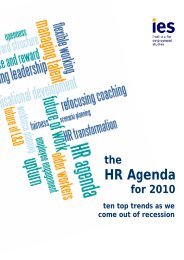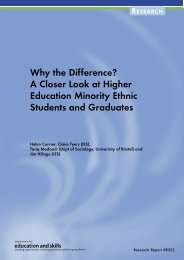Post-16 Transitions: a Longitudinal Study of Young People with ...
Post-16 Transitions: a Longitudinal Study of Young People with ...
Post-16 Transitions: a Longitudinal Study of Young People with ...
You also want an ePaper? Increase the reach of your titles
YUMPU automatically turns print PDFs into web optimized ePapers that Google loves.
and sixth form colleges (11 per cent). Six per cent <strong>of</strong> young<br />
people in education reported that they were studying at<br />
specialist colleges for learners <strong>with</strong> learning difficulties/<br />
disabilities.<br />
<strong>Young</strong> people who had a statement <strong>of</strong> SEN whilst in<br />
compulsory schooling were more likely than those <strong>with</strong>out<br />
statements to be continuing their studies at school or <strong>with</strong>in a<br />
specialist college for people <strong>with</strong> learning difficulties or<br />
disabilities (LDD), and less likely to be at an FE or tertiary<br />
college (Table 5.8).<br />
A similar pattern was observed for young people who had<br />
attended a special school compared <strong>with</strong> those from a<br />
mainstream school. Not surprisingly, young people <strong>with</strong><br />
different SEN types were also attending different types <strong>of</strong><br />
educational establishment.<br />
<strong>Young</strong> people <strong>with</strong> communication and interaction difficulties,<br />
and those <strong>with</strong> sensory and/or physical disabilities, were<br />
more likely than those <strong>with</strong> cognition and learning difficulties<br />
or behavioural, emotional and social development needs to<br />
have remained at school post-<strong>16</strong> or be attending a specialist<br />
Table 5.8: Educational establishment, by SEN (per cent)<br />
College <strong>of</strong> Further Education or<br />
tertiary college<br />
Communication<br />
and Interaction<br />
Cognition<br />
and<br />
learning<br />
Sensory<br />
and/or<br />
physical<br />
Behaviour /<br />
emotional /<br />
social<br />
development<br />
49 63 40 53<br />
School 21 14 27 19<br />
Sixth Form college 12 10 15 12<br />
Specialist college for learners <strong>with</strong><br />
learning difficulties/ disabilities<br />
8 4 10 7<br />
Residential school 2 1 2 1<br />
Independent or other college 1 1 1 2<br />
Residential Training Colleges 1 0 1 0<br />
Private training centre 1 0 0 0<br />
University 0 1 1 0<br />
Other 4 5 2 5<br />
Don't know 1 0 1 1<br />
N = 232 444 87 108<br />
Note: All percentages are weighted percentages, unless otherwise stated<br />
Source: IES/MORI 2003<br />
66 <strong>Post</strong>-<strong>16</strong> <strong>Transitions</strong> <strong>of</strong> <strong>Young</strong> <strong>People</strong> <strong>with</strong> SEN: Wave 2

















